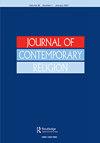Agrarian Spirit: Cultivating Faith, Community, and the Land
IF 0.6
3区 哲学
0 RELIGION
引用次数: 0
Abstract
dramaturgical production. His elaboration of embodied spiritualities related to outdoor recreation bears additional scholarly analysis (as he suggests). He focuses specifically on surfing, but there are resources that highlight (although not in the depth that LeVasseur does here) the religious cultural production stemming from other activities such as skiing, rock climbing, kayaking, and hiking. There are few ethnographies, unfortunately, about these embodied modes of spirituality. Two case studies of post-Anthropocene dramaturgies which combine environmentalism, sex, and gender include the advocacy group “FuckForForest” (FFF) and the emergence of people who self-identify as EcoSexuals. For some scholars of religions these are described as new modes of performance and identification. LeVasseur suggests that these are instantiations of dark green religious production at the cultural margins. Yet will they stay marginal as the impact of climate disruption persists and worsens? “The challenge to the academy, and especially religious studies”, LeVasseur argues, “is to see how studies such as these can possibly, or will actually contribute to resilient transformations, if at all” (136). Towards the end of his introduction, LeVasseur asks his reader to consider the following questions: “How do we bring beauty to the academy? How do we ask questions appropriate to the Anthropocene, so we can better understand how human animals are trying to protect such beauty, or are seeking to rediscover it? How can we help create institutions where knowledge of and ceremony with beauty are their reason for being?” (xxx). Indeed, as he artfully articulates, we have not yet developed an academic culture that can even reflect on how something like beauty, imagined as a harmonious embodied interbeing of material and non-material agents, might be codified, sought after, and studied. Climate Change, Religion, and Our Bodily Future provides the first steps towards an academy that might be able to ask and answer such poignant questions.农民精神:培育信仰、社区和土地
戏剧制作。他对与户外娱乐相关的具体精神的阐述需要额外的学术分析(正如他所建议的)。他特别关注冲浪,但也有一些资源突出了(尽管没有LeVasseur在这里所做的深度)源自滑雪、攀岩、皮划艇和徒步旅行等其他活动的宗教文化生产。不幸的是,关于这些具体化的精神模式,几乎没有民族志。两个结合了环保主义、性和性别的后人类世戏剧案例研究包括倡导团体“FuckForForest”(FFF)和自我认同为生态性工作者的人的出现。对于一些宗教学者来说,这些被描述为表现和认同的新模式。LeVasseur认为,这些都是文化边缘的深绿色宗教生产的实例。然而,随着气候破坏的影响持续并恶化,它们会保持边缘化吗?LeVasseur认为,“学院面临的挑战,尤其是宗教研究”,“是看看像这样的研究如何可能或实际有助于有弹性的转变,如果有的话”(136)。在他的介绍接近尾声时,LeVasseur请读者考虑以下问题:“我们如何将美带到学院?我们如何提出适合人类世的问题,以便更好地了解人类动物是如何试图保护这种美的,或者是如何寻求重新发现它的?我们如何帮助创建以美的知识和仪式为理由的机构?”(xxx)。事实上,正如他巧妙地阐述的那样,我们还没有发展出一种学术文化,甚至可以反思像美这样的东西,被想象成物质和非物质主体的和谐融合,是如何被编纂、追求和研究的。气候变化、宗教和我们的身体未来为建立一所能够提出和回答这些尖锐问题的学院迈出了第一步。
本文章由计算机程序翻译,如有差异,请以英文原文为准。
求助全文
约1分钟内获得全文
求助全文
来源期刊

Journal of Contemporary Religion
RELIGION-
CiteScore
1.20
自引率
0.00%
发文量
59
期刊介绍:
Journal of Contemporary Religion is an international peer reviewed journal. Its purpose is to both document and evaluate the anthropological, sociological, psychological, and philosophical aspects of emerging manifestations of religiosity in any part of the world—whether within innovative movements or mainstream institutions. The term ''religion'' in the title of this journal is understood to include contributions on spirituality. Moreover, as the journal title suggests, the focus is on contemporary issues. Therefore, the editors of Journal of Contemporary Religion welcome submissions which deal with: classical topics in the study of religion, such as secularisation and the vitality of religion or traditional sectarian movements; more recent developments in the study of religion, including religion and social problems, religion and the environment, religion and education, the transmission of religion, the materialisation and visualisation of religion in various forms, new forms of religious pluralism, the rise of new forms of religion and spirituality, religion and the Internet, religion and science, religion and globalisation, religion and the economy, etc. theoretical approaches to the study of religion; discussions of methods in relation to empirical research; qualitative and quantitative research and related issues. The Journal includes reviews of books which reflect the above themes.
 求助内容:
求助内容: 应助结果提醒方式:
应助结果提醒方式:


